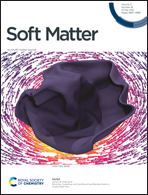Persistence length regulates emergent dynamics in active roller ensembles†
Abstract
Active colloidal fluids, biological and synthetic, often demonstrate complex self-organization and the emergence of collective behavior. Spontaneous formation of multiple vortices has been recently observed in a variety of active matter systems, however, the generation and tunability of the active vortices not controlled by geometrical confinement remain challenging. Here, we exploit the persistence length of individual particles in ensembles of active rollers to tune the formation of vortices and to orchestrate their characteristic sizes. We use two systems and employ two different approaches exploiting shape anisotropy or polarization memory of individual units for control of the persistence length. We characterize the dynamics of emergent multi-vortex states and reveal a direct link between the behavior of the persistence length and properties of the emergent vortices. We further demonstrate common features between the two systems including anti-ferromagnetic ordering of the neighboring vortices and active turbulent behavior with a characteristic energy cascade in the particles velocity field energy spectra. Our findings provide insights into the onset of spatiotemporal coherence in active roller systems and suggest a control knob for manipulation of dynamic self-assembly in active colloidal ensembles.



 Please wait while we load your content...
Please wait while we load your content...